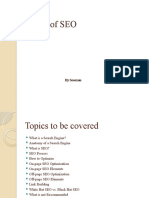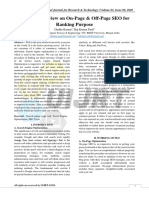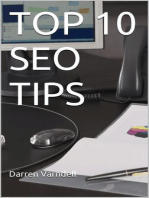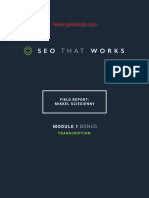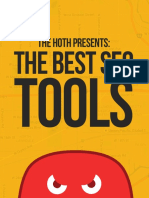What Is SEO
What Is SEO
Uploaded by
kumari yogeshreeCopyright:
Available Formats
What Is SEO
What Is SEO
Uploaded by
kumari yogeshreeOriginal Title
Copyright
Available Formats
Share this document
Did you find this document useful?
Is this content inappropriate?
Copyright:
Available Formats
What Is SEO
What Is SEO
Uploaded by
kumari yogeshreeCopyright:
Available Formats
What is SEO?
It’s the practice of increasing both the quality and quantity of website traffic as well as exposure to your brand
through non-paid (“also known as organic”) search engine results.
Aim Of SEO
1. Aim -Visibility
2. How- ranking
3. Why -traffic
Process Of Search Engine: (Bots and Spiders)
1. Crawling: Read: this means reading the website and coding content is crawling.
2. Indexing: Store: This means storing your website page’s copy in a search engine database.
3. Retrieval: Fetch: This means fetching the results from the database when the user asks for it.
4. Ranking: Rank:
Bot and Spider come in 3 to 4 days or in a week to read the data from the website. It depends upon the data you are
uploading to the website. If the bots and spiders did not get the new content then they will not come back to your
website.
Tool: Google search console: we request Google to visit our website and the content in your database.
Frequency of Crawling: It means that it decides by Google itself.
Challenges Faced on Search Engine Optimization:
To be visible:
1. Finding relevant user queries (Keyword).
2. Being visible among lakhs of results.
3. Getting a free (organic) listing instead of paid when user.
4. Optimizing map listing for location-based searches.
5. Optimizing web page position on 1st page.
Google my business: It’s a tool where we can send the all information related to your company or website. It can help
local Seo. And it is called google business profile.
The Factor of SEO Ranking
1. On-Page SEO or On-Page Factors: means those ranking factors which we apply on our website.
2. Off Page SEO or Off Page Factors: means those factors which we apply outside of our website.
On-Page Ranking Factor
1. URL Structure: The URL structure, readability, and word used can contribute to its t
2. Title Tag: search engines use the title tag as an indicator of a page’s topic. (Character limit = 60)
3. Meta description Or Meta Tag: (Words Character = 155 Characters)
4. Internal Link: Links using anchor text to other content on your site that provides readers with more
information. Anchor text gives readers and search engines an understanding of what the next page is
about. (Dwell Time)
5. Body Content: The content on the page fuels googles understanding of the content and often fulfills the
user’s intent. This can include paragraphs, lists, tables, and more. (Header, body, and footer) (word limit =
700 – 1000 words)
6. Images: Optimized images expand organic visibility. (Image Alternative Text Character Limit= 125
characters)
7. Website Speed: If your page has large and unoptimized header images, you might have a low LCP (Large
contentful Paint) score in core web vitals. (Tool For this GSI = Google Speed insight)
8. Website Structure-sitemap: Website Architecture example sitemap means that sheet in which we include
all the links related to your website (Home, Category, subcategory, sub-sub category) tool for making the
site map XML site maps.
9. Keywords (Most Important Factor): Terms added to online content in order to improve search engine
rankings for those search terms. It must be included in our content that keyword which is used called
keyword stuffing.
It is in a short tail and a long tail.
There are some tools for keyword research
1. SEMrush
2. Spy Fu
3. Uber suggests.
4. Ahref
5. Moz keyword explorer
6. kwfinder
Types of keywords:
1. Primary Keyword: it means that the primary keyword is the topic. (Must we try to use 2% of the
content length)
2. Secondary Keyword: it means that secondary keywords can become good subtopics. (We must try to
URL made by up to domain and Page name.
Off Page SEO: It focuses on ranking factors that occur outside of your website. Like Brand Mentions And Backlinks-
Creating Reputation References from other websites
Backlinks: Backlinks are links from outside domain that point to pages on your. A backlink is a link created when one
website
Do Follow And No Follow Links
Do follow- Allow google and Other Search engines to point back to your website or blog
No Follow-A no follow link is link that does not count as point in the page’s favor does not boost page rank and
doesn’t help a page’s placement in the SERPs
Backlink Audience
Crawler
Authority : It Refers to strength and score of given website.
PA: Page Authority : when a google count the authority of the page. And it should be in do follow link.
DA: Domain Authority : where we want to count whole page authority.
Website for Authority Checker: Domain Authority checker-Moz
DA: Score Between 40 to 50 are considered averages .
DA Authority between 50-60 must be rated as good
Scores above 60 rate
It is called Link building Process.
OFF Page Seo Check List
1. Search Engine Submission:
2. Free Classified submission:
3. Image Submission:
4. PDF/PPT submission:
5. Social Bookmarking
6. Forum Posting:
7. Guest Blogging:
8. Social Bookmarking:
9. Press Release:
10. Infographic Submission:
11. Video Submission:
12. Q&A submission:
Paid Link: It mean that we have to paid for the backlinks.
Tool :Free domain authority checker
Assignment Topic: Data Science Course
Search Submission:
Url:
DA:
Spam:
You might also like
- Blackbook Project On Internet MarketingDocument88 pagesBlackbook Project On Internet MarketingSreejith Nair52% (27)
- SEO Presentation FinalDocument26 pagesSEO Presentation FinalAditi Singh50% (2)
- SEODocument7 pagesSEOIjazNo ratings yet
- Chapter 6: Internet Technologies and Search Strategies: Prepared by Dr. Derek Sedlack, South UniversityDocument43 pagesChapter 6: Internet Technologies and Search Strategies: Prepared by Dr. Derek Sedlack, South UniversityM HAFIDZ RAMADHAN RAMADHAN100% (1)
- Search Engine Optimization 1Document30 pagesSearch Engine Optimization 1lifoca3586No ratings yet
- SEO ProposalDocument13 pagesSEO ProposalpilesfistulasurgeryNo ratings yet
- SEO Proposal Zera CreativeDocument14 pagesSEO Proposal Zera CreativepilesfistulasurgeryNo ratings yet
- Basics of SEO: by Engr Talha Bin ZahidDocument29 pagesBasics of SEO: by Engr Talha Bin ZahidSeoexonNo ratings yet
- SEO BasicsDocument18 pagesSEO BasicsAlexandra CiarnauNo ratings yet
- 762-SEO Training v3.4Document52 pages762-SEO Training v3.4Mak Bosley100% (1)
- DM Module-2Document21 pagesDM Module-2jeevitha siriNo ratings yet
- Seo DidmDocument29 pagesSeo Didmneerajratta.recruiterNo ratings yet
- University Institute of Engineering Department of Computer Science & EngineeringDocument17 pagesUniversity Institute of Engineering Department of Computer Science & EngineeringAmit ShahNo ratings yet
- SEO Proposal Zera CreativeDocument14 pagesSEO Proposal Zera Creativeja27yaNo ratings yet
- Overview: How Does A Search Engine Work?Document4 pagesOverview: How Does A Search Engine Work?Sandeep SandyNo ratings yet
- Digital Marketing (SEO)Document20 pagesDigital Marketing (SEO)Bhagya PatilNo ratings yet
- Introduction To Search Engine Optimization Program: 11 Dec 2010 MumbaiDocument65 pagesIntroduction To Search Engine Optimization Program: 11 Dec 2010 MumbaiswathravNo ratings yet
- SEO ScriptDocument11 pagesSEO ScriptAbhishek Mathur100% (1)
- 6 - Seo.Document4 pages6 - Seo.Ana Garcia AtanceNo ratings yet
- General SEO Information: 1.1 History of Search EnginesDocument19 pagesGeneral SEO Information: 1.1 History of Search EnginesPallab DattaNo ratings yet
- Digital Marketing Training in Bangalore: SEO Interview Questions & AnswersDocument11 pagesDigital Marketing Training in Bangalore: SEO Interview Questions & AnswersVellore SathishNo ratings yet
- Unit - 5 Digital MarketingDocument6 pagesUnit - 5 Digital MarketingkarthiknoneNo ratings yet
- Basics of SEO: by SeoexonDocument30 pagesBasics of SEO: by SeoexonSeoexonNo ratings yet
- SEO Methodology, SEO Techniques, SEO TipsDocument22 pagesSEO Methodology, SEO Techniques, SEO Tipsmoinjafri12100% (8)
- Tema SEODocument65 pagesTema SEOfjcastillejoma.comNo ratings yet
- Seo MseDocument10 pagesSeo MseroNo ratings yet
- DSMM Unit-1 NotesDocument12 pagesDSMM Unit-1 Notesanjanesh mauryaNo ratings yet
- Top 25 SEO Terms Every Beginner ShouldDocument14 pagesTop 25 SEO Terms Every Beginner ShouldzpieknoNo ratings yet
- Search Engine Optimization & SEO Proposal: On Page & Web Site Analysis and RecommendationsDocument5 pagesSearch Engine Optimization & SEO Proposal: On Page & Web Site Analysis and RecommendationsSiddharth mishraNo ratings yet
- Step by Step Diy SEO For BeginnersDocument10 pagesStep by Step Diy SEO For Beginnersmelanie.netNo ratings yet
- SEO PracticeDocument51 pagesSEO PracticeGangadhar BiradarNo ratings yet
- Module 3Document32 pagesModule 3therealsirjhunNo ratings yet
- Assignment 2Document8 pagesAssignment 2Prakash ShuklaNo ratings yet
- Assignment 2: SourceDocument8 pagesAssignment 2: SourcePrakash ShuklaNo ratings yet
- Search Engine Optimization After MidsDocument35 pagesSearch Engine Optimization After MidsallahdittahammadNo ratings yet
- Literature Review On On-Page & Off-Page SEO For Ranking PurposeDocument5 pagesLiterature Review On On-Page & Off-Page SEO For Ranking PurposeUIJRT United International Journal for Research & TechnologyNo ratings yet
- Power PointDocument25 pagesPower PointPaengNo ratings yet
- Digital Marketing Unit 2Document26 pagesDigital Marketing Unit 2shreya.fruity23No ratings yet
- Seo Question Paper WordDocument10 pagesSeo Question Paper Wordrahul870malviyaNo ratings yet
- SEO Report ThriamDocument5 pagesSEO Report Thriammmksocial72No ratings yet
- Performance AiDocument7 pagesPerformance Aianumitr1105No ratings yet
- Namit_SEODocument20 pagesNamit_SEOndoshi923No ratings yet
- TrendPickle's SEO For BeginnersDocument24 pagesTrendPickle's SEO For Beginnersvaibhavgupta98No ratings yet
- Search Engine OptimizationDocument13 pagesSearch Engine OptimizationImran ShaikhNo ratings yet
- Seminar: Search Optimization (S O)Document35 pagesSeminar: Search Optimization (S O)Jeron P ThomasNo ratings yet
- All Questions and Answers About SEO 1. What Is SEO & Why Is It So Important?Document10 pagesAll Questions and Answers About SEO 1. What Is SEO & Why Is It So Important?Udoy PaulNo ratings yet
- 100+ Essential SEO Terms Marketers Should Know in 2022Document8 pages100+ Essential SEO Terms Marketers Should Know in 2022zpieknoNo ratings yet
- Unit 2 KMB N 207Document24 pagesUnit 2 KMB N 207Azhar AhamdNo ratings yet
- What Is SEODocument9 pagesWhat Is SEOvvanshika005No ratings yet
- Search Engine Optimization - NOtesDocument8 pagesSearch Engine Optimization - NOtesBounty HunterNo ratings yet
- Website AnalysisDocument7 pagesWebsite AnalysisBharti KashyapNo ratings yet
- Web Crawling & SEODocument20 pagesWeb Crawling & SEOkhandelwalayush621No ratings yet
- SEO For Developers: These Are The Things We Will Go OverDocument24 pagesSEO For Developers: These Are The Things We Will Go OverShalomNo ratings yet
- DM Merged PDFDocument51 pagesDM Merged PDFSurabhi AgarwalNo ratings yet
- SEO TerminologyDocument73 pagesSEO Terminologyvandana bolakheNo ratings yet
- SEO On-Page Optimization Proven Tactics To Boost Your Website's VisibilityDocument34 pagesSEO On-Page Optimization Proven Tactics To Boost Your Website's VisibilityShimon ChohenNo ratings yet
- Seo Analysis ReportDocument10 pagesSeo Analysis ReportAngusNo ratings yet
- A Review Paper On Seo For Ranking and Effectiveness Techniques in Context of Google Search Engine - January - 2020 - 1578922497 - 2705481Document2 pagesA Review Paper On Seo For Ranking and Effectiveness Techniques in Context of Google Search Engine - January - 2020 - 1578922497 - 2705481MerinNo ratings yet
- Intro To SeoDocument40 pagesIntro To Seoanderson100% (1)
- 10 Key Things - SEO Proposal PDFDocument19 pages10 Key Things - SEO Proposal PDFGitanjali SinghNo ratings yet
- CV 01Document2 pagesCV 01kumari yogeshreeNo ratings yet
- MBA Farewell Collection List (2022-2023)Document14 pagesMBA Farewell Collection List (2022-2023)kumari yogeshreeNo ratings yet
- Seo Keyword ResearchDocument4 pagesSeo Keyword Researchkumari yogeshreeNo ratings yet
- What Is SEODocument9 pagesWhat Is SEOkumari yogeshreeNo ratings yet
- B - SIP Working Log Book and FeedbackDocument8 pagesB - SIP Working Log Book and Feedbackkumari yogeshreeNo ratings yet
- ServiceDocument1 pageServicekumari yogeshreeNo ratings yet
- Sales & DistributionDocument6 pagesSales & Distributionkumari yogeshreeNo ratings yet
- 3rd Semester SyllabusDocument9 pages3rd Semester Syllabuskumari yogeshreeNo ratings yet
- Submission Sites ListDocument6 pagesSubmission Sites Listkumari yogeshreeNo ratings yet
- Summer Training GuidelinesDocument10 pagesSummer Training Guidelineskumari yogeshreeNo ratings yet
- Google Form ResponsesDocument75 pagesGoogle Form Responseskumari yogeshreeNo ratings yet
- Dashboard - Practice File PracticeDocument31 pagesDashboard - Practice File Practicekumari yogeshreeNo ratings yet
- Google Account Structure and Keyword ResearchDocument5 pagesGoogle Account Structure and Keyword Researchkumari yogeshreeNo ratings yet
- The Evergreen On-Site Seo GuideDocument20 pagesThe Evergreen On-Site Seo Guidecloud artNo ratings yet
- Domain AutorityDocument1 pageDomain AutoritySyed AliNo ratings yet
- 04 Backlink Analysis ReportDocument110 pages04 Backlink Analysis ReportserpzenNo ratings yet
- SEO Strategy TemplateDocument9 pagesSEO Strategy TemplateDulce PereiraNo ratings yet
- Basics of SEO: by SeoexonDocument30 pagesBasics of SEO: by SeoexonSeoexonNo ratings yet
- Digital Marketing KT Final2Document34 pagesDigital Marketing KT Final2ASMITA DAS MBA 2021-23 (Delhi)No ratings yet
- Module 1 Bonus Field Report Mikkel Sciegienny TranscriptionDocument6 pagesModule 1 Bonus Field Report Mikkel Sciegienny Transcriptionamit tiwariNo ratings yet
- Le Tkhan ZuiDocument71 pagesLe Tkhan ZuiNoah OliechNo ratings yet
- Backlink DA 70Document4 pagesBacklink DA 70Faiq Yazdani100% (3)
- Top Seo Tools PDFDocument12 pagesTop Seo Tools PDFMatt100% (1)
- Digital Marketing Course in JalandharDocument6 pagesDigital Marketing Course in JalandharDforce AcademyNo ratings yet
- Rahul Malviya: Digital Marketing ExecutiveDocument3 pagesRahul Malviya: Digital Marketing ExecutivedashboardzomatoNo ratings yet
- Build BacklinksDocument17 pagesBuild BacklinksKashif NaeemNo ratings yet
- Beginner SEO TermsDocument183 pagesBeginner SEO TermsClaudio JoaquimNo ratings yet
- Seo MseDocument10 pagesSeo MseroNo ratings yet
- Blog Report-1Document65 pagesBlog Report-1Tarannum ShaikhNo ratings yet
- Competitor AnalysisDocument20 pagesCompetitor AnalysisMD. RAFI AHMED EMONNo ratings yet
- Bonus 3 - The White Hat Hacks PDFDocument14 pagesBonus 3 - The White Hat Hacks PDFSAranNo ratings yet
- Offpage TechniquesDocument12 pagesOffpage TechniquesRajesh KumarNo ratings yet
- Marketing and Outreach Team PresentationDocument10 pagesMarketing and Outreach Team PresentationShadreck MubangaNo ratings yet
- Digital Analytics Individual Assignment - BHATT AlokDocument28 pagesDigital Analytics Individual Assignment - BHATT AlokAlok BhattNo ratings yet
- The Essential Step-by-Step Guide To Internet Marketing: The Building Blocks For Succeeding With Marketing On The WebDocument35 pagesThe Essential Step-by-Step Guide To Internet Marketing: The Building Blocks For Succeeding With Marketing On The WebraifmusaNo ratings yet
- SEO Tactic - Rank Higher On GoogleDocument14 pagesSEO Tactic - Rank Higher On Googledeepanshu sajwanNo ratings yet
- Analisa Dan Implementasi SEO Search Engine Optimization Konten Website Untuk Algoritma Google Panda Dan Yahoo Naskah PublikasiDocument22 pagesAnalisa Dan Implementasi SEO Search Engine Optimization Konten Website Untuk Algoritma Google Panda Dan Yahoo Naskah PublikasiFajar AbdulsiddiqNo ratings yet
- Pillar Page Blog Post TemplateDocument5 pagesPillar Page Blog Post Templatealex KNo ratings yet
- Google Knowledge Panel Glossary of Terms - (Beginner's Guide To Google's Knowledge Graph and Knowledge Panels) - WikiSauceDocument39 pagesGoogle Knowledge Panel Glossary of Terms - (Beginner's Guide To Google's Knowledge Graph and Knowledge Panels) - WikiSaucePanel Rank (panelrank.com)No ratings yet
- Digital MarketingDocument5 pagesDigital MarketingGUNJAN AGARWALNo ratings yet
- SEO GuideDocument3 pagesSEO GuideHimal GhimireNo ratings yet






















